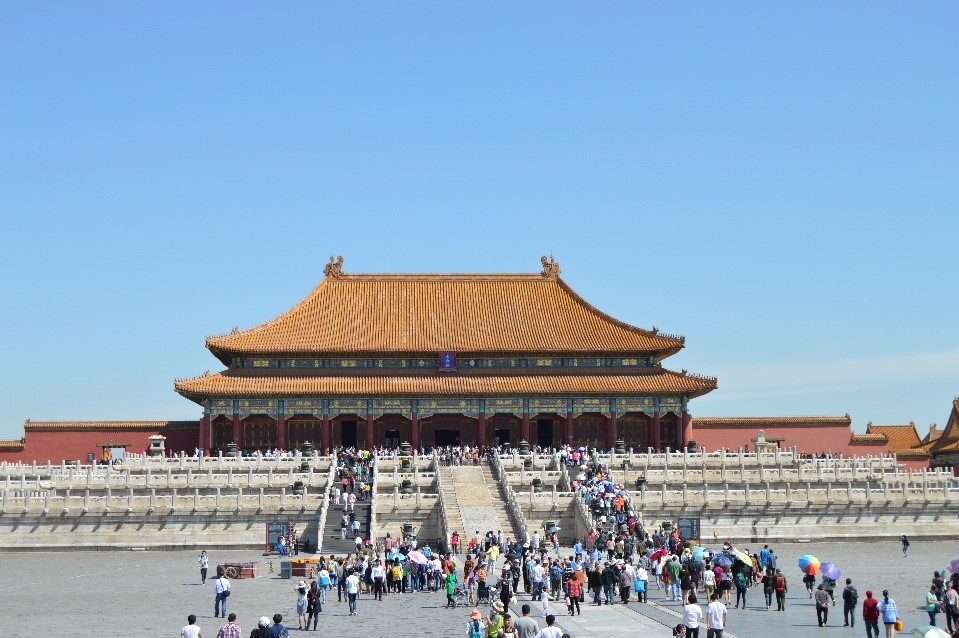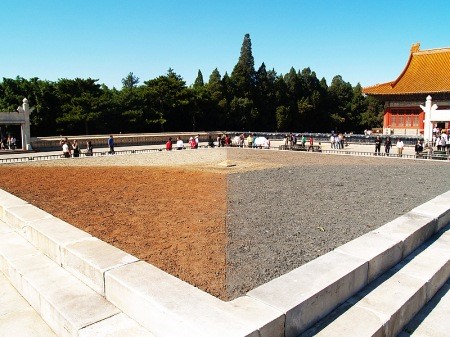Author: Jiawei Xia
The visit to Forbidden City made up most of the trip on May 4th. The Forbidden City has a rectangular shape, with an area of 720000 m2. The whole construction of the city started from over six hundred years ago. It is said there are a total of 9999 houses in this place. This number might be specifically designed, since the number “9” always represents the highest dignity in China.
We started the visit to Forbidden City by entering its front gate, Meridian Gate in the south. It was a giant building, with five entrances distributed symmetrically. We passed through the main gate in the middle, which was intended only for the emperor during ancient times. Through several more doors, we arrived at the Hall of Supreme Harmony. The most famous throne in China, with a history of almost 500 years, has always been placed in the middle of the hall. Behind the hall, a giant stone carve with nine dragons lies in the middle of the stairs. It is said the stone weighs over 200 tons. 400 years ago, by pouring water on the ground to form ice during a winter, people transported the stone from 50 miles away to the palace.

The Hall of Union, following the Hall of Supreme Harmony, was very unique. It was a very small pavilion, but was used to store the 25 imperial seals of the Qing Dynasty. It lay between the Palace of Heavenly Purity and Palace of Earthly Tranquility, and represented the harmony of China between heaven and earth under the authority of the royal families.
The exhibition of jewelry might be the most unforgettable part in the imperial city. After many years of war and unsettling, some of the most valuable masterpieces were lucky enough to be saved and shown to all the visitors. The exhibitions was huge, ranging from ivory over two meters long and jade pieces each weighing two or three tons, to crystal opium bottles (carved from inside) as little as two centimeters in height. One of the most amazing piece, was called “田黄三连印”. It had three seals, connected to each other with chains. Surprisingly, all the three seals and all the chains were carved out of a single piece of jade. The art itself has made it priceless.

After the Forbidden City, we went on into the Jinshan Park. Jinshan is a man-made mountain using the soil and rocks from the moat of the Forbidden City. At the pavilion on the top of the mountain, we received an amazing view of all the royal structures in Beijing. Over the past 500 years, people built a series of gates all the way from Tiananmen to the Drum Tower. Imagine if the Emperor stood in front of the Hall of Supreme Harmony, he would be able to see things several kilometers away through all the gates. The ancient Beijing city was designed to be perfectly symmetric around the line connecting all the gates. Under the clear and blue sky, the whole imperial city was shining golden light on all of us. Surprisingly, we were even able to see the structures at the Beijing Olympic Park (the Nest), which is on the far-north end of the city.
Our next stop was the Beihai (North Sea) Park. Though called the “North Sea”, Beihai was actually another man-made lake. In the park, we saw the famous White Tower of Taoism. It had a shape of wine bottle, with white color covering most of its surface. From the other side of the Beihai Lake, the White Tower and its reflection in the water formed an unforgettable scene.
On previous days, we passed by the front door of Xinhua Gate, the south and main entrance to Zhongnanhai area. Nowadays, this area is the working and living space for the leaders of China. After Beihai Park, we went onto a street on the north of Zhongnanhai. The lake of Middle-South Sea started from the bottom of the street we stood on and extended to the other side. Most of the buildings were hidden behind the trees and could not be seen. Still, we were able to imagine how the presidents and prime ministers of China lived and made decisions here.
We went through the South Changjie and North Changjie Streets, where Prof. He lived till elementary school. Over forty years have passed, many buildings from his time still existed. On the bank of the Forbidden City’s moat, senior people were flying kites as high as three or four hundred meters high.
Our last visit during the day was the Zhongshan Park. The park used to be another royal park and was renamed in memorial of Zhongshan Sun, the leader of earliest modern revolutions in China. The Five-Color Soil was placed in the park. During ancient times, the soil of five different colors represented all the lands of China and was worshiped by all the emperors.

